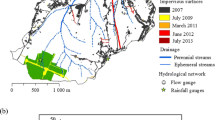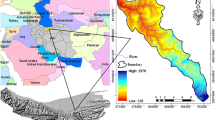Abstract
The paper presents an analysis of runoff behaviour of four urban catchments between the municipalities of Belo Horizonte and Contagem in Brazil, linked to their land use. Two years of online measurement of flow data, combined with spatial analysis, was linked through runoff modelisation with EPA SWMM. The coefficients of Nash obtained varying between 0.75 and 0.87 demonstrated an adequate modelling approach. A 1-year rain series was applied to evaluate the runoff behaviour of actual land cover and that of 2002. The peak flows normalised to watershed surfaces revealed as the most urbanised (85%) watershed Ressaca with 178 L/ha/s, three times more runoff intensive than the least urbanised (41%) Mergulhão with 67 L/ha/s. Statistical analysis of land cover data and modelling results on watershed and sub-watershed level showed main correlations between hydrological parameters such as peak flow, average event flow and restitution time, but also between land cover and runoff coefficient. This approach gave a linear relation between runoff and green surface, with a runoff coefficient of 0.86 for fully urbanised zone and 0.43 for full “green” cover. Prospective simulation with actual urbanisation rates varying from 4 to 34 ha/year suggested an increase between 6 and 18% of the flows and a possible end of urbanisation within the next two to three decades. These findings should contribute to a better understanding of hydrological impact of Belo Horizonte urbanisation and to the restauration of its Lake Pampulha.







Similar content being viewed by others
References
Adinsoft (2018) Statistical software & data analysis add-on for Excel | XLSTAT
ANA and SNIRH (2018) Atlas Esgotos — Sistema Nacional de Informações sobre Recursos Hídricos. http://www.snirh.gov.br/portal/snirh/snirh-1/atlas-esgotos. Accessed 3 Jan 2019
Aroeira R (2012) O Plano Diretor de Drenagem de Belo Horizonte - Desafios na Implantação do Sistema de Monitoramento Hidrológico e Alerta contra Inundações. PBH
Aroeira R, Arantes Braga R, Donária Pereira M, Carvalho Aguiar I (2010) The municipal sanitation plan for the Municipality of Belo Horizonte. NOVATECH 2010
Baker DB, Richards RP, Loftus TT, Kramer JW (2004) A new flashiness index: characteristics and applications to midwestern rivers and streams1. JAWRA J Am Water Resour Assoc 40:503–522. https://doi.org/10.1111/j.1752-1688.2004.tb01046.x
Benini R de M, Mendiondo EM (2015) Urban occupation and its hydrologic impacts in the upper Mineirinho watershed. Floresta E Ambiente 22:211–222. https://doi.org/10.1590/2179-8087.103114
Boggs JL, Sun G (2011) Urbanization alters watershed hydrology in the Piedmont of North Carolina. Ecohydrology 4:256–264. https://doi.org/10.1002/eco.198
Burns D, Vitvar T, McDonnell J, Hassett J, Duncan J, Kendall C (2005) Effects of suburban development on runoff generation in the Croton River basin, New York, USA. J Hydrol 311:266–281. https://doi.org/10.1016/j.jhydrol.2005.01.022
Carvalho I, Aroeira R (2012) Política de Combate a Inundações de Belo Horizonte. PBH SUDECAP
Chen J, Hill AA, Urbano LD (2009) A GIS-based model for urban flood inundation. J Hydrol 373:184–192. https://doi.org/10.1016/j.jhydrol.2009.04.021
Chi-Water (2018) SWMM5. Chi-Water
Coutinho W (2007) Emprego da flotação a ar dissolvido no tratamento de cursos d’água - Avaliação de desempenho da estação de tratamento dos corregos Ressaca e Sarandi afluentes a represa da Pampulha. UFMG SMARH
Duarte ARB (2009) Histórico da urbanização de Belo Horizonte a partir da década de 70: uma análise das políticas públicas ambientais e de urbanização do município. 11
Dudula J, Randhir TO (2016) Modeling the influence of climate change on watershed systems: adaptation through targeted practices. J Hydrol 541:703–713. https://doi.org/10.1016/j.jhydrol.2016.07.020
Elliott AH, Trowsdale SA (2007) A review of models for low impact urban stormwater drainage. Environ Model Softw 22:394–405. https://doi.org/10.1016/j.envsoft.2005.12.005
Foster SSD, Chilton PJ (2004) Downstream of downtown: urban wastewater as groundwater recharge. Hydrogeol J 12:115–120. https://doi.org/10.1007/s10040-003-0296-y
Franchini M, GALEATI G, BERRA S (1998) Global optimization techniques for the calibration of conceptual rainfall-runoff models. Hydrol Sci J 43:443–458. https://doi.org/10.1080/02626669809492137
Friese K, Schmidt G, Carvalho de Lena J et al (2010) Anthropogenic influence on the degradation of an urban lake – the Pampulha reservoir in Belo Horizonte, Minas Gerais, Brazil. Limnol - Ecol Manag Inland Waters 40:114–125. https://doi.org/10.1016/j.limno.2009.12.001
Fritsch FED (2013) Influência do uso e ocupação do solo nas vazões de pico na bacia hidrográfica do alto rio ligeiro, Pato Branco–PR. B.S. thesis, Universidade Tecnológica Federal do Paraná
Graf WH (2000) Hydraulique fluviale: écoulement et phénomènes de transport dans les canaux à géométrie simple. PPUR presses polytechniques
Huong HTL, Pathirana A (2013) Urbanization and climate change impacts on future urban flooding in Can Tho city, Vietnam. Hydrol Earth Syst Sci 17:379–394
Jacobson CR (2011) Identification and quantification of the hydrological impacts of imperviousness in urban catchments: A review. J Environ Manag 92:1438–1448. https://doi.org/10.1016/j.jenvman.2011.01.018
James W, Rossman LA, James WRC (2010) User’s guide to SWMM 5. CHI, Guelph, Ont.
Marsalek J, Cisneros BJ, Karamouz M, et al (2008) Urban water cycle processes and interactions: urban water series - UNESCO-IHP. CRC Press
Meals DW, Dressing and SA (2008) Surface water flow measurement for water quality monitoring projects,. EPA
Mejía AI, Moglen GE (2010) Impact of the spatial distribution of imperviousness on the hydrologic response of an urbanizing basin. Hydrol Process 24:3359–3373. https://doi.org/10.1002/hyp.7755
Miller JD, Hess T (2017) Urbanisation impacts on storm runoff along a rural-urban gradient. J Hydrol 552:474–489. https://doi.org/10.1016/j.jhydrol.2017.06.025
Miller JD, Kim H, Kjeldsen TR, Packman J, Grebby S, Dearden R (2014) Assessing the impact of urbanization on storm runoff in a peri-urban catchment using historical change in impervious cover. J Hydrol 515:59–70. https://doi.org/10.1016/j.jhydrol.2014.04.011
Nascimento N, Heller L, Baptista M, et al (2006) Long-term uncertainties and potential risks to urban waters in Belo Horizonte. 8
Nash JE, Sutcliffe JV (1970) River flow forecasting through conceptual models part I — a discussion of principles. J Hydrol 10:282–290. https://doi.org/10.1016/0022-1694(70)90255-6
O’Driscoll M, Clinton S, Jefferson A, Manda A, McMillan S (2010) Urbanization effects on watershed hydrology and in-stream processes in the Southern United States. Water 2:605–648. https://doi.org/10.3390/w2030605
PBH SMOBI, PBH Sudecap (2015) Política de redução do risco de inundações, em Belo Horizonte Programa de recuperação ambiental de Belo Horizonte – programa Drenurbs
Petrucci G (2012) La diffusion du contrôle à la source des eaux pluviales urbaines : confrontation des pratiques à la rationalité hydrologique. Phdthesis, Université Paris-Est
Resck RP, Neto JFB, Coelho RMP (2007) Nova batimetria e avaliação de parâmetros morfométricos da Lagoa da Pampulha (Belo Horizonte, Brasil). Rev Geogr 3:24–37
Rossman LA (2015) Storm water management ModelUser’s Manual Version 5.1. EPA, National Risk Management Laboratory Office of Research and Development U.S. Environmental Protection Agency
Salvadore E, Bronders J, Batelaan O (2015) Hydrological modelling of urbanized catchments: a review and future directions. J Hydrol 529:62–81. https://doi.org/10.1016/j.jhydrol.2015.06.028
Seidl M, Petrucci G, Lorgeoux C, Nilo DON (2014) Assessment of dry and wet weather pollutant fluxes in a small urban watershed of Belo Horizonte (Brazil). In: ICUD 2014,13th International Conference on Urban Drainage, Sarawak, Malaysia, 7-12 September 2014
Silva T (2014) Suivi et modélisation de la dynamique des cyanobactéries dans les lacs urbains au sein de leur bassin versant. Phdthesis, Université Paris-Est
Silva TF das G, Vinçon-Leite B, Giani A et al (2016) Modelagem da Lagoa da Pampulha: uma ferramenta para avaliar o impacto da bacia hidrográfica na dinâmica do fitoplâncton. Eng Sanit E Ambient 21:95–108. https://doi.org/10.1590/S1413-41520201600100125692
Singh VP (1988) Hydrologic systems: rainfall-runoff modeling. Pearson College Div, Englewood Cliffs
Snyder FF (1938) Synthetic unit-graphs. Trans Am Geophys Union 19:447. https://doi.org/10.1029/TR019i001p00447
de Souza J (2008) A expansão urbana de Belo Horizonte e da Região Metropolitana de Belo Horizonte: o caso específico do município de Ribeirão das Neves. Tese de Doutorado
US EPA O (2014) Storm Water Management Model (SWMM)
Verbeiren B, Van De Voorde T, Canters F et al (2013) Assessing urbanisation effects on rainfall-runoff using a remote sensing supported modelling strategy. Int J Appl Earth Obs Geoinf 21:92–102. https://doi.org/10.1016/j.jag.2012.08.011
Vietz GJ, Walsh CJ, Fletcher TD (2016) Urban hydrogeomorphology and the urban stream syndrome: treating the symptoms and causes of geomorphic change. Prog Phys Geogr 40:480–492. https://doi.org/10.1177/0309133315605048
Viola MR, Mello CR, Beskow S, Norton LD (2014) Impacts of land-use changes on the hydrology of the Grande River basin headwaters, Southeastern Brazil. Water Resour Manag 28:4537–4550. https://doi.org/10.1007/s11269-014-0749-1
Walsh CJ, Fletcher TD, Burns MJ (2012) Urban stormwater runoff: A new class of environmental flow problem. PLoS One 7:e45814. https://doi.org/10.1371/journal.pone.0045814
Walsh CJ, Roy AH, Feminella JW, et al (2005) The urban stream syndrome : current knowledge and the search for a cure
WCMD (2000) Detecting trend and other changes in hydrological data
WMO (ed) (2008) Guide to Hydrological Practices Volume II Management of Water Resources and Application of Hydrological Practices, 6th edn. WMO World Meteorological Organization, Geneva
Wu JY, Thompson JR, Kolka RK, Franz KJ, Stewart TW (2013) Using the Storm Water Management Model to predict urban headwater stream hydrological response to climate and land cover change. Hydrol Earth Syst Sci 17:4743–4758. https://doi.org/10.5194/hess-17-4743-2013
Acknowledgements
The authors will especially acknowledge Municipality of Belo Horizonte, PBH Sudecap, for making available their hydrological data and PBH Propam for their GIS support.
Funding
The project was financially supported by FINEP CT Hidro as a part of project BRUM and by FAPEMIG through different scholarships and by ChiWater through PCSWMM modelling software.
Author information
Authors and Affiliations
Corresponding author
Additional information
Responsible editor: Philippe Garrigues
Publisher’s note
Springer Nature remains neutral with regard to jurisdictional claims in published maps and institutional affiliations.
Rights and permissions
About this article
Cite this article
Seidl, M., Hadrich, B., Palmier, L. et al. Impact of urbanisation (trends) on runoff behaviour of Pampulha watersheds (Brazil) . Environ Sci Pollut Res 27, 14259–14270 (2020). https://doi.org/10.1007/s11356-019-06029-6
Received:
Accepted:
Published:
Issue Date:
DOI: https://doi.org/10.1007/s11356-019-06029-6




